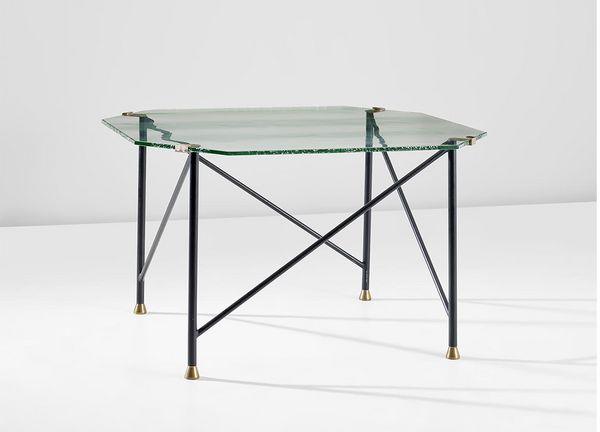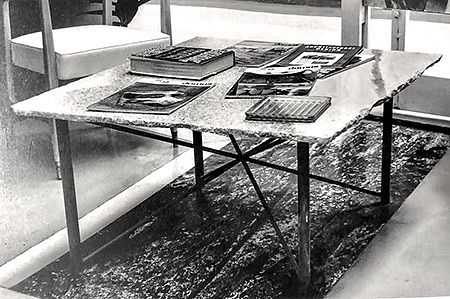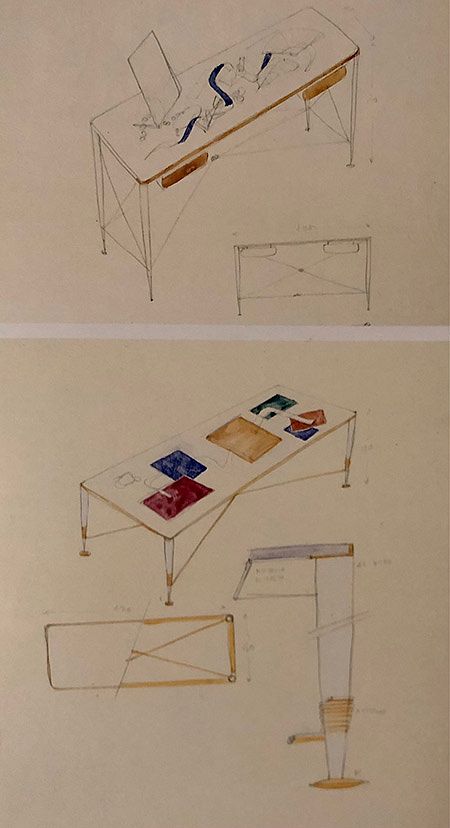Gio Ponti, Rare occasional table, circa 1950, lot 3. Design London.
Gio Ponti's prescient design masterpiece features in our Design auction in London on 31 October.
By Brian Kish, Curator and Specialist in 20th Century Italian Architecture and Design, Consultant to the Gio Ponti Archives since 2006
This hitherto unknown 1952 Ponti design reveals the scope of his experiments in metalwork that provided an opportunity to create dynamic forms with a fundamentally different material from the “natural” solid woods and veneers for which he is widely known. In a world where almost every table, chair, and cabinet has a wood structure and surface, this untypical switch to metal construction prompted him to explore a more concise visual vocabulary.
Instead of simply highlighting the load-bearing qualities of metals he began using them to demonstrate his own idiosyncratic idea of pictographic tectonics. This first came about in a 1952 design for the waiting room of his architectural office: a coffee table with a granite top supported by a criss-crossing diagonal bracing. Inside his vast atelier there were often casual groupings of prototypes for chairs, stools, and side tables, all structured with complex variations of metal supports. Even the long rectangular drafting tables had expressive black metal framework holding the white formica tops.
Gio Ponti, coffee table with steel and and granite top with chiselled edge, executed by Giordano Chiesa, 1952. Photo: © Gio Ponti Archives.
In designing the present octagonal dining table, Ponti reached a new stage in the development
of metal supports: no criss-crossing of rods this time but by a simple diagonal bracing that connects each of the four legs. The scheme has a nearly hieratic, yet jaunty up and down momentum that is evident on all four sides.
A custom Fontana Arte treatment gives the tabletop glass a delicate, almost eerie presence. The watery surface was achieved by pouring molten lead crystal into a special mould. This process invented by Pietro Chiesa was unique to the firm at that time and used extensively in their 1930s – '40s structural glass furniture. With its softly glazed look, the crystal surface of this dining table is made more dramatic with a hand-chiselled perimeter edge.
The transparent octagonal shape is held in place by four brass clips that are elongated, folded, and cantilevered from the four table legs. This exquisite twist of Mannerist design exemplifies Ponti's subtle attention to detail, highly complex but seemingly effortless. As always his line tends to generate optical motion but still achieves a solid, definite form. Meanwhile, enigmatic games are waiting to be deciphered with hints, such as numerical divisions landing on the number 8. They are
also manifest, albeit concealed, in the octagonal top where eight Isosceles triangles appear subliminally in the double divisions on each of the four sides.
This likely prototype octagonal table, with a blackened steel frame, was designed by Ponti in the interim period when Fontana Arte found itself without a creative director. Between Pietro Chiesa's death in 1948 and 1954 when Max Ingrand took over the directorship, Ponti was asked by the company to help lead it during the post war recovery period. As his architecture practice prospered with numerous commissions, he could not afford to serve again as art director as he had done in 1933. He did however recommend one of his students to Fontana Arte. Besides, he also took advantage of the firm’s superlative standards to produce some of his custom commissions, such as the glass-top pedestal table with blue enamelled metal base for the Villa Arreaza, which again involved a folded metal clip technique to join top and base.
In the early 1950's Ponti was clearly at the top of his game. It was his most prolific period in the realm of architecture and design. Over the entire decade, he would coordinate a steady stream of private and public architectural commissions side by side, while managing the development of numerous prototypes for interior furniture, lighting, and other design elements, which sometimes led to large scale production batches.
This experimental table was born during this intensely productive phase soon after he started working with Rima, coming up with dramatic and complex chair designs while also developing a prototype car design for an Alfa Romeo body, Linea diamante.
Drawing from 1946, showing studies for two tables in brass and painted iron.
Image: © Gio Ponti Archives.
Along his entire journey of endless invention, he never fully abandoned any particular form. He kept reviving them according to his theory of architecture as an art embodied in a living crystal, forever striving towards the essential. The crystal, most dear to him, is best exemplified in his own words:
Pure architecture is a crystal. When it is pure, it is as pure as a crystal - magic, closed, exclusive, autonomous, uncontaminated, uncorrupted, absolute, definitive like a crystal.
Discover More from Design, London >
Recommended Reading
Designing History: The furniture of Gabriella Colucci and Franco Pierluisi >
A Masterpiece by Josef Hoffman, Cofounder of the Wiener Werkstätte >


